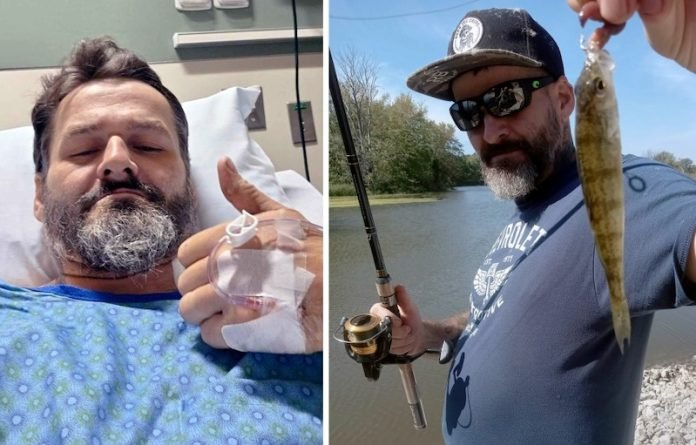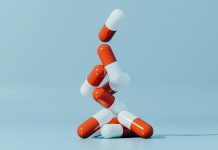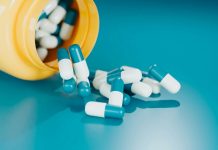
Kenny Busch was desperate to find answers.
He had struggled with symptoms of deep vein thrombosis — including blood clots, severe leg pain, open sores and fatigue — for far too long.
Unable to work or even function on a day-to-day basis, the 45-year-old turned to the Venous Health Program at University of Michigan Health Frankel Cardiovascular Center, hopeful he might finally get some answers – and help.
Health issues for the Morenci, Mich., resident began more than 20 years ago when he was diagnosed with deep vein thrombosis, a condition in which blood clots form in the deep veins of the legs.
His DVT led to post-thrombotic syndrome and venous insufficiency, complications of DVT that cause the symptoms Busch was experiencing.
Despite their efforts, doctors were unable to alleviate Busch’s symptoms — until he met with Clare Harris, N.P., Minhajuddin Khaja, M.D., and the team of specialists in the U-M Health VHP Program.
“Mr. Busch’s post-thrombotic syndrome and venous insufficiency resulted in long-term negative effects, including pain, swelling in both of his legs, ulcers and inefficient blood flow from the veins in his legs back to his heart,” said Khaja.
The blood was pooling in his veins, causing fluid to collect in his tissues, severe inflammation in the skin and pain with walking.
At the beginning of Busch’s venous health issues, he recalls working an hour or two at a time, laying down to rest in between.
As the years went on, he was forced to stop working altogether.
“I’m not someone who likes to lay around,” Busch said, reflecting on the life he was living and the realization that treatment he’d been receiving wasn’t helping.
“I was wandering between vascular surgeons because nobody was offering anything to help me. They stripped veins in my legs, which helped a little, but eventually I developed an open ulcer on the left side of my right foot.”
Changing paths
Meeting with Harris and Khaja changed everything for Busch.
“I met Dr. Khaja, and he said he thought he could help.”
The U-M Health Venous Health Program brings together a multidisciplinary team of experts from many specialties in one location to treat patients with all forms of vascular disease.
Specialty areas include interventional radiology, vascular medicine, vascular sonography and vascular surgery.
“Care is coordinated through Clare Harris, N.P., who serves to guide patients through the diagnostic process and coordinate their care across the multiple physicians,” said vascular surgeon Andrea Obi, M.D.
“With one stop, patients are able to get expert input on optimal lifestyle, medical, interventional and surgical options for treatment of their disease.”
“Our program is dedicated to figuring out the patient’s overall venous health. Our centralized team weighs in on a patient’s history and potential treatments,” said Khaja of the group that meets twice a month to discuss complex patient conditions.
“We offer a truly comprehensive, multidisciplinary approach to patient care and a very stable system for follow-up. And should complications arise where we need a different member of the team, everyone is highly accessible and very committed to the patient.”
Khaja says he and his team begin by evaluating each patient.
“We then determine who in our group is best able to handle the particular condition — whether it’s superficial venous disease, deep venous disease or a combination.
“We hear our patient’s stories, understand the road they’ve taken before coming to us and ask what symptoms bother them the most. Mr. Busch told us, ‘I just want my legs to stop hurting. I want to be able to get up and do things.’”
Creating a partnership
Khaja says many factors play into a diagnosis like Busch’s.
“Because of the symptoms of venous disease, patients might not be able to move or exercise. They may be depressed. They don’t eat well. Or they smoke.”
All these factors, he says, make the condition even worse.
The next step in treatment involves imaging to determine the anatomic location of disease affecting the patient’s overall venous health.
“With Mr. Busch, we found that he had extensive chronic venous occlusions from the popliteal veins of his knee all the way up to his inferior vena cava, the large vein that carries deoxygenated blood from the lower and middle body to the right atrium of the heart,” said Khaja.
Busch was offered both medical and interventional treatment options. “We told him what we could do for him, but also what we expect from his standpoint in order to have a positive outcome,” said Khaja.
“Our program requires a true partnership and commitment from our patients. This includes things like exercising, showing up for follow-up visits, taking anticoagulant medication and quitting smoking.”
A complex procedure
Ultrasound imaging and a CT scan with venous contrast dye were used to show the entire venous system in the lower half of Busch’s body.
“The patient’s veins, essentially in his inferior vena cava and his belly all the way down to his knees, had scarred down and occluded, preventing blood from traveling back to the heart,” said Khaja.
“He would need a complex procedure that involved small incisions in the groin and neck to enable us to cross the occlusions and place stents that would open his veins.
“We performed a percutaneous venous reconstruction of his inferior vena cava and his iliac veins to improve blood flow,” said Khaja.
This was done using a total of five stents, from Busch’s inferior vena cava down to his external iliac veins and common femoral veins.
The stent used to open Busch’s inferior vena cava was part of a clinical trial featuring a device that mirrors a patient’s native vasculature.
The trial is designed to evaluate the performance, safety and efficacy of the GORE® VIAFORT Vascular Stent for treatment of symptomatic inferior vena cava obstruction.
“This stent is an interesting combination of rigidity but conformability all in one,” said Khaja, noting that Michigan Medicine is an active enrolling center for the trial and one of eight enrolling centers in the United States.
Life changing results
Today, Busch is happy with his results.
“About a week after my procedure I started using my exercise bike and now ride 14 miles every other day. I stopped smoking cigarettes and I take anticoagulants.”
He says he knew he was finally getting back to his old self during a fishing experience in the fall.
“I went fishing for 12 hours with my buddy. Before, I couldn’t fish for more than a few hours because just standing there would really destroy me.
It’s a big deal when you can function at a higher level and get out of bed and stay out. That changes life quite a bit.”
“The patient has had a very positive initial result and is truly contributing to his own care,” said Khaja, reflecting on the importance of the patient and medical team partnership.
“Mr. Busch comes to his appointments. He takes his medication. He does all the things that we recommend, and he does them well.
Because of that, he’s had a positive outcome. And should any turns or twists or detours come along in the future, I know he trusts us, and we trust him.”
Written by Jane Racey Gleeson.
If you care about wellness, please read studies about how ultra-processed foods and red meat influence your longevity, and why seafood may boost healthy aging.
For more information about wellness, please see recent studies that olive oil may help you live longer, and vitamin D could help lower the risk of autoimmune diseases.



